Appendix H - Historical Archaeological and ... - CBP.gov
Appendix H - Historical Archaeological and ... - CBP.gov
Appendix H - Historical Archaeological and ... - CBP.gov
You also want an ePaper? Increase the reach of your titles
YUMPU automatically turns print PDFs into web optimized ePapers that Google loves.
2004; Fitting, 1978a; Fitting, 1978b; Tuck, 1978; Gibbon et al, 2000). However, detailed<br />
cultural chronologies for the portion of Minnesota within 100 miles of the Canadian border are<br />
largely nonexistent, although chronologies have been developed for other parts of the state<br />
(Harrison, 1985).<br />
The Minnesota State Historic Preservation Office (SHPO) has developed a historic preservation<br />
plan titled Gaining Ground: A Preservation Plan for Minnesota’s Historic Properties 2006-<br />
2010 (2006) that includes cultural contexts for both the prehistoric <strong>and</strong> historic periods. The<br />
foundation for the current plan was created in 1995, in a document titled Preserving Minnesota:<br />
a Plan for Historic Properties in the New Century (MN SHPO, 1995). The prehistoric cultural<br />
chronology for Minnesota divides the approximately 11,500-year continuum into five main<br />
phases or cultural traditions (MN SHPO, 2010). From earliest to latest, the defined traditions<br />
are:<br />
Paleo-Indian Period (see Section 1.1.1)<br />
Archaic Period<br />
Woodl<strong>and</strong> Period<br />
Plains Village Tradition<br />
Mississippian Tradition<br />
The prehistoric context is available at<br />
http://www.mnhs.org/shpo/survey/docs_pdfs/HistoryArchitectureSurveyManualOctober2010.pdf<br />
Archaic Period<br />
During the Archaic Period (ca. 8,000 B.P. –2,500 B.P.), the subsistence practices focused on<br />
hunting <strong>and</strong> gathering as suggested by the presence of flaked stone spear <strong>and</strong> dart points, bifaces,<br />
scrapers, <strong>and</strong> knives. Groundstone <strong>and</strong> copper tools also appear during this time period. Typical<br />
sites include stone quarries <strong>and</strong> resource procurement areas, tool production sites, hunting <strong>and</strong><br />
game processing sites, <strong>and</strong> camps.<br />
Woodl<strong>and</strong> Period<br />
The Woodl<strong>and</strong> Period (ca. 500 B.C. (2,500 B.P.) – 900 A.D., <strong>and</strong> 1650 A.D. in some areas)<br />
witnessed a transition from a somewhat mobile settlement system to a more sedentary lifeway<br />
with semi-permanent villages. The development <strong>and</strong> use of pottery <strong>and</strong> more elaborate human<br />
burials are key elements of the period. Artifact assemblages typically include bone artifacts,<br />
bone <strong>and</strong> shell beads <strong>and</strong> ornaments, ground stone implements, <strong>and</strong> small projectile points. Sites<br />
include resource procurement sites, villages, camps, hunting <strong>and</strong> processing sites, <strong>and</strong> burial<br />
mounds.<br />
Plains Village Tradition<br />
The Plains Village Tradition (ca. A.D. 900–1300 A.D.) is characterized by the development of<br />
villages focused on cultivation of crops along river banks <strong>and</strong> major drainages. Structures<br />
include lodges <strong>and</strong> stockaded village compounds. The range of artifact types produced during<br />
the Plains Village Tradition far exceeded the variability in earlier assemblages. Among the items<br />
Northern Border Activities H-48 July 2012
















